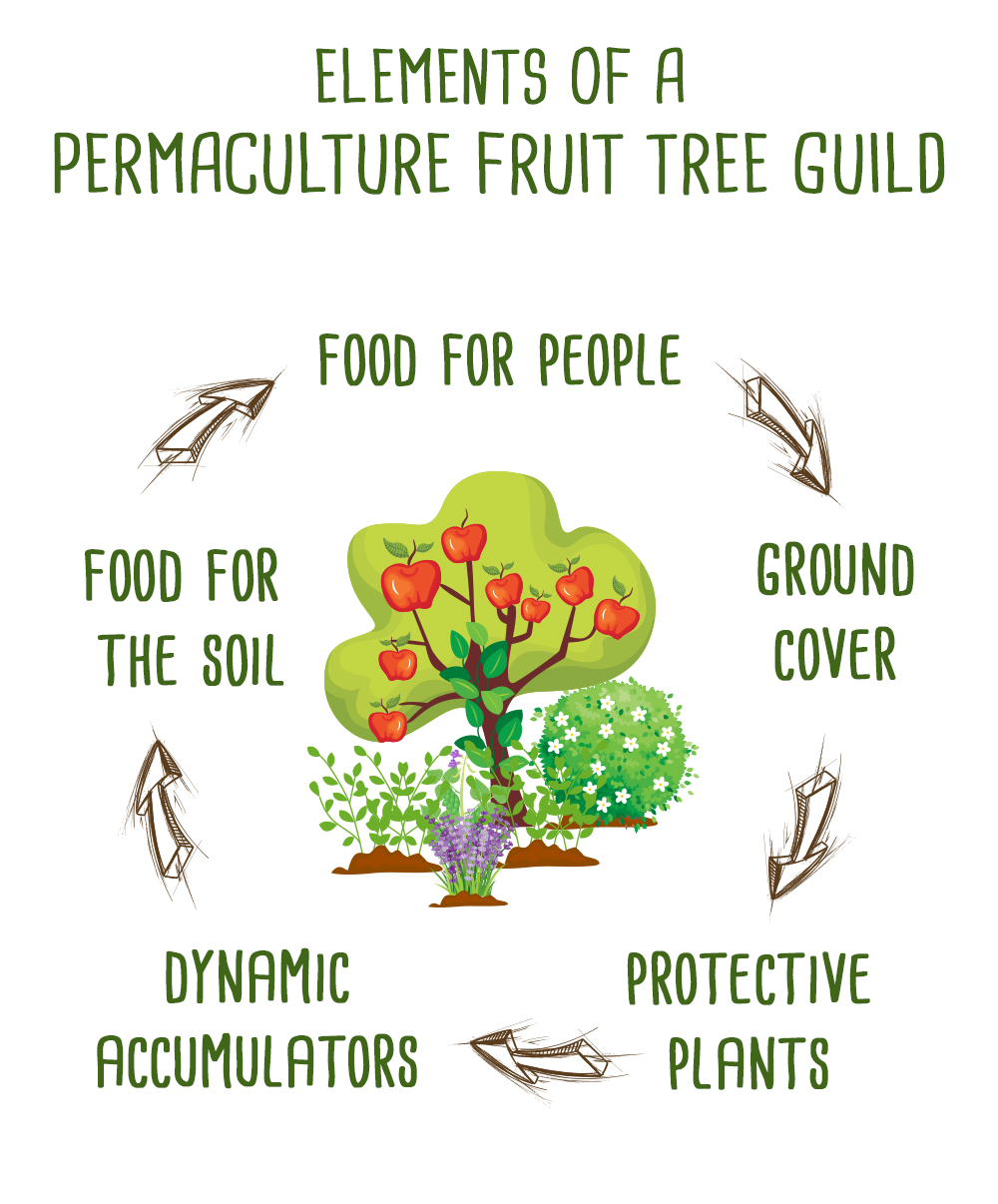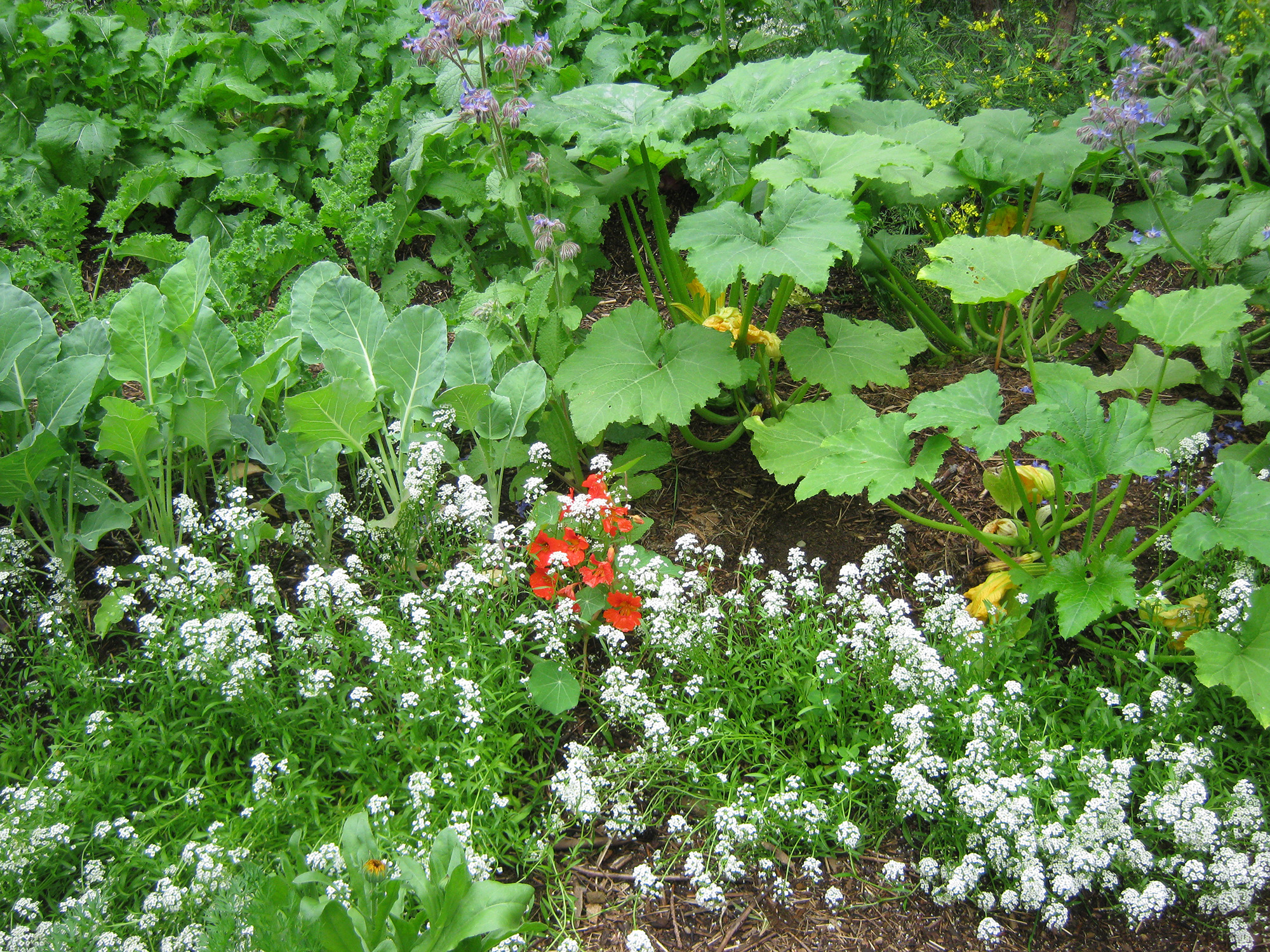
As with most things permaculture, exactly which plants you should put into or leave out of your permaculture fruit tree guilds…depends. It depends on where you live, what your climate is like, what your property aspect is, what your soil is like, what you like to eat, etc.
So instead of asking which plants to use, let’s look at what types of plants you need in a guild. This will give you an excellent foundation to work with.
Types of plants in a permaculture fruit tree guild
Here is a general list of the types of plants that would be right at home in a guild. Within each type, there are many to choose from. I will suggest a few, then you can go do some research and find the ones that work in your climate, and within your system.
Food for people (and animals)
The central element of a guild is generally a fruit tree of some sort; but it can also be a nut tree, or a large berry bush. And there will also be food plants among the supporting plants.
Some of these can be food for you, some will be food for beneficial insects, and some can be used as food for any animals you may be raising.
Examples of central tree/bush: Fruit tree, nut tree, large berry bush such as blueberry or Saskatoon (service berry), etc.
Around the central plant, you can grow food plants – perennial vegetables such as artichokes, or self-seeding veggies such as herbs or mustard greens.
Food for your soil
A good portion of the supporting plants of the guild should provide food for the soil. Nitrogen fixing plants are very important in any planting. They give any tree or other planting a good start in life.
A really good food forest is often almost 90% nitrogen fixing trees at the beginning, until the food trees are big enough, and the nitrogen fixers can be removed, or at least thinned out.
When working out what to plant for a single apple tree guild in a backyard situation, be sure to plant some nitrogen fixing plants such as clovers or legumes to chop and drop.
Examples: Clover, peas and beans (lots of different kinds, so research the ones that grow well where you live), alfalfa, lupines, vetch.
Dynamic accumulators
Next, we want to add in what are commonly known as dynamic accumulators or nutrient accumulators in permaculture circles. There is still much debate about the actual role of dynamic accumulators, and whether they really do as they say – bring up nutrients from far below the surface.
I think it only makes sense that a plant with a deep taproot would have access to different nutrients than shallow rooted plants, and play a major role in guild health.
Different dynamic accumulators are purported to accumulate different minerals, and release these when they are chop and dropped, or composted, and fed back to your soil. So having a diverse mix of these plants can help ensure a balance of nutrients in the soil of your guild.
Take a look at this thread on permies.com to see a list of plants that are believed to be dynamic accumulators.
As you will see, many of these plants are what most consider to be ‘weeds’. But many are also edible (and nutritious), useful in home remedies, as well as very attractive to beneficial insects. So it’s a win-win-win when you plant these in your guilds and gardens.
Another benefit of deep-rooted plants is their ability to break up compacted soils, and to bring air and water down deep into the soil. Great stuff.
Examples: Comfrey, dandelion, chicory, lamb’s quarters, yarrow.
Ground covers
Ground cover plants are used to protect the soil from erosion, help hold in moisture, and many are useful as bee forage and nitrogen fixing as well. Low growing clovers fit the bill there. But a ground cover can also be a mulch, or chop and drop. Whatever it takes to keep the soil from being exposed anywhere.
Ground covers can also be useful for holding loose soils together – especially useful on slopes.
And of course, a ground cover that includes those lovely, low-growing alpine strawberries is also a delicious and nutritious addition to your diet.
Examples: Short clovers, New Zealand spinach, Miner’s lettuce, Alpine strawberry.
Protectors
Many plants can serve to protect the main guild element. If it is a plant that attracts beneficial insects, it can help the whole guild. Or it could deter specific insects that might otherwise cause trouble for your main guild planting. Growing a variety of plants that attract a variety of beneficial insects into your guild will give you the best protection. The more the merrier!
Examples: let herbs such as chervil and cilantro go to seed – their flowers are very attractive to beneficial insects. These herbs will self-seed readily. Plants in the onion family are also good protector plants.
Protectors can be more than just plants in a guild. Snakes, toads, and lizards play an important role in pest control. So pile up some rocks or sticks, and invite some critters to the party. They will love having a place to hide, and will in turn help to keep many pests from chomping up your favorite foods.
There are many options, and hardly any of them are wrong
I think this is one of the areas of permaculture where people worry too much about ‘getting it wrong’. I don’t think you can get it wrong, as long as you provide at least one of each of the above types of plants, I think it will work out beautifully.
If you want to experiment, plant a different guild around each tree, and see if there is any difference. Does one have fewer pest problems than the others? Is one growing faster than the others? If so, then perhaps you should emulate those plantings in the other guilds.
There really isn’t a blueprint for this. What you plant in your guild depends on so many things – climate, soil, pest pressure, aspect, etc. You really just have to research what grows well in your area, and do some experimenting. But the list above should help you get started.
Often, one plant can perform more than one service in a guild. Clover is a nitrogen fixer and a ground cover, as well as bee fodder. Comfrey – the most popular permaculture plant – is a dynamic accumulator, attractive to bees, and it puts on a LOT of leaf growth in a season, so it adds a great deal of organic matter as well. And! It’s medicinal.
Many flowers act as attractants to pollinators, beneficial insects, and birds; but are also edible or medicinal. And they can add another factor: beauty. Adding flowers to your guild can be purely for your enjoyment; and there’s nothing wrong with that.
You could also build a guild as a mini food forest: a tree, a berry bush, some herbaceous plants (including some nitrogen fixers), ground covers, and plants that form an edible tuber.
When the tree is big enough, add a vining plant of some sort, such as Scarlett runner beans; or a grape vine if the tree is strong and tall enough. And you want to make sure there are some chop and drop plants to continuously feed the soil.
For an excellent read about putting plant guilds together, and growing lots of healthy food in your own yard, pick up Toby Hemenway’s book, Gaia’s Garden. You’ll be awfully glad you did.
So many plants, so many options! My advice is to have fun with it. Make sure you have all the different types of plants that are useful in a guild; and after that, the sky’s the limit. As long as it grows where you live, it will probably work fine in a guild.
I hope this little guide to the 5 things to put in your permaculture fruit tree guilds was helpful. Building guilds is another excellent tool from the permaculture tool box, and will help you understand the forest ecosystem, so that when you’re ready to plant your food forest, you’ll have the information you need.
Drop my a note if you have any feedback or questions about guilds, and why they’re important.
Health, Hope & Happiness
Tracy

Hi Tracy.
Thanks so much for an exceptionally informative post. I learned a lot from reading this. Had no idea about the dynamic accumulators , or nitrogen fixers, but it definitely makes a lot of sense!
I feel like I want to get going on a fruit tree guild right away. 😉
Thanks again for an excellent post!
Best wishes,
Michael
Thanks,Michael
I’m glad that it made sense to you, and inspired you! It’s really fun putting all these puzzles together in permaculture systems. I hope you get a chance to create some fruit tree guilds of your own.
Cheers
Tracy